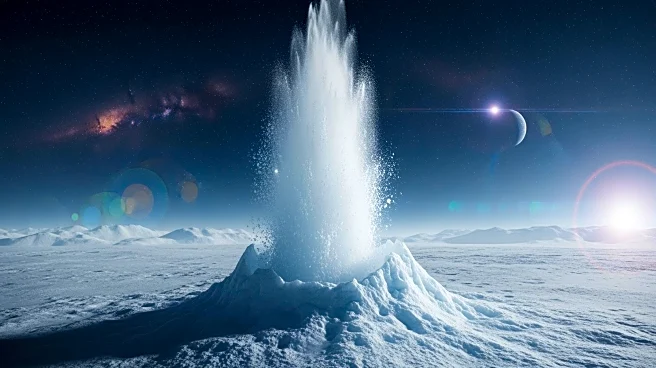What's Happening?
Recent findings from NASA's Cassini mission have unveiled significant heat flow at the north pole of Saturn's moon Enceladus, suggesting it may have the conditions necessary to support life. Previously,
heat loss was thought to be limited to the south pole, where geysers release water vapor and ice particles. The discovery of heat flow at the north pole indicates that Enceladus is more thermally active than previously believed, with a global, salty ocean beneath its icy surface. This ocean, containing liquid water, warmth, and essential chemical ingredients, is considered one of the most promising environments for extraterrestrial life in the solar system. The study, led by Dr. Georgina Miles from the Southwest Research Institute, highlights the moon's long-term thermal balance, crucial for sustaining life.
Why It's Important?
The discovery of Enceladus' thermal activity and its stable ocean environment is significant for the search for extraterrestrial life. The moon's ability to maintain a balance between energy gained and lost through tidal heating suggests its ocean could remain liquid over long periods, providing a stable environment for life to potentially develop. This finding enhances Enceladus' status as a key target in the quest to find life beyond Earth. The research also offers insights into the moon's geological activity, which could inform future missions aimed at exploring its subsurface ocean.
What's Next?
Scientists are now focused on determining the age of Enceladus' ocean, as its longevity could indicate stable conditions for life to emerge. Future missions may aim to explore the moon's ocean using robotic probes or landers, with thermal readings helping to estimate the thickness of its ice shell. This research underscores the importance of long-term missions to ocean worlds that may harbor life, and the potential for data to reveal secrets decades after being obtained.
Beyond the Headlines
The study of Enceladus' thermal activity not only advances the search for extraterrestrial life but also highlights the need for sustained scientific exploration of ocean worlds. Understanding the moon's heat flow and ice thickness is crucial for planning future missions, which could provide deeper insights into its potential for supporting life. The findings emphasize the importance of long-term data collection and analysis in uncovering the mysteries of distant celestial bodies.











